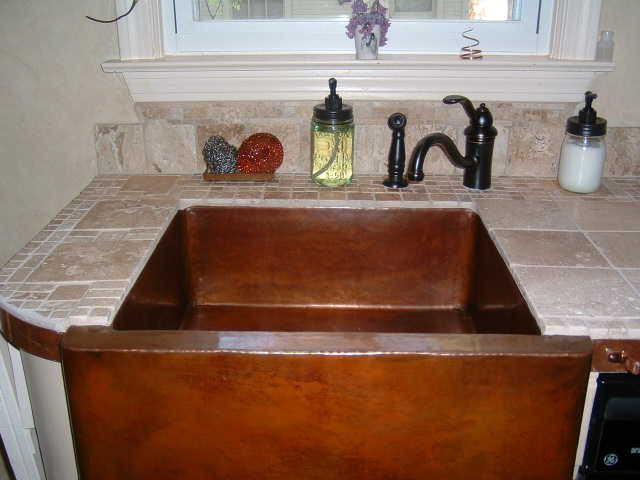 If you are really serious about buying copper sinks, then there are definitely a few things you should know before making any final decision. Now starting with your budget, when you do a thorough shopping research for buying the copper sink, you will be surprised to see the wide range of prices in copper sinks. A quick research on the internet will show you the copper sink range from $200.00 USD to as close as $3,000 USD. Cost savings is the purpose of most people in the country now. They prefer going for a cheap copper sink while shopping rather than choosing the expensive one. However you get the quality for what you pay. There are a certain things that people should definitely bear in mind while buying cheap copper sinks. The construction and welding on the copper sink should be carefully seen. May be it is not the most important thing to be careful about, but is one of the main concerns. Make sure that you make the copper sink as per your size specifications to avoid any future problems. Copper as a material has been in demand forever and many people have been using it as the base material for building kitchen sinks or as pots and pans, however make sure you get an alloy as opposed to 100% copper, it will be way to soft to sustain. The most common alloy is about 3% zinc, this gives the strength needed for the kitchen use and needs.
If you are really serious about buying copper sinks, then there are definitely a few things you should know before making any final decision. Now starting with your budget, when you do a thorough shopping research for buying the copper sink, you will be surprised to see the wide range of prices in copper sinks. A quick research on the internet will show you the copper sink range from $200.00 USD to as close as $3,000 USD. Cost savings is the purpose of most people in the country now. They prefer going for a cheap copper sink while shopping rather than choosing the expensive one. However you get the quality for what you pay. There are a certain things that people should definitely bear in mind while buying cheap copper sinks. The construction and welding on the copper sink should be carefully seen. May be it is not the most important thing to be careful about, but is one of the main concerns. Make sure that you make the copper sink as per your size specifications to avoid any future problems. Copper as a material has been in demand forever and many people have been using it as the base material for building kitchen sinks or as pots and pans, however make sure you get an alloy as opposed to 100% copper, it will be way to soft to sustain. The most common alloy is about 3% zinc, this gives the strength needed for the kitchen use and needs.
Specific Features of Handmade Saltillo Mexican Floor Tile
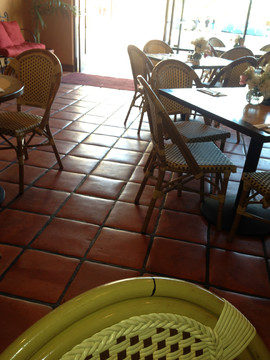
Amidst a sea of floor tiles in the market, you must be able to identify the rustic glow of handmade Saltillo Mexican tiles. Besides their outstanding quality, some other specific features would enable you to identify the real Saltillo tiles at a glance. Let’s explore them. Otherwise, you’ll be played out by tricky traders at the time of purchase. So, here are some outstanding features you see only in Mexican Saltillo tiles. See whether you can make them out.
- Stripes of colors
You can see color stripping in most of the Saltillo tiles and that’s not a fault in the process of manufacturing. Those stripes are not blemishing either. And they do not add any ugliness to the product. Instead they decorate the overall surface of the tile. These stripes are a result of the varied temperatures inside the kiln. All the tiles are stacked in piles one on the other in the kiln for firing. So, not all the tiles get an equal temperature which results in these beautiful stripping designs. So, at a glance, you must be able to identify that they are real Mexican Saltillo floor tiles.
- Bumps on the surface
These bumps are not defects occurred at the production level, but customary signs that show you the uniqueness of handmade Saltillo Mexican tiles. Some may be lime pops, the deposits of minerals on the surface. The uneven surface is not at all a disturbance to the smooth and accurate installation process. You can proudly say that they are specially meant for your floor by the hands of skilled Mexican artisans.
- Varied size and thickness levels
These are yet another characteristic of the handmade Saltillo Mexican floor tiles. The thickness of the tile could be different from lot to lot. So, it’s advisable for you to buy your tiles from the same lot. However, this does not matter in the installation since the workers always apply rather thick grout lines to get that smooth final finish.
- Chips and variations in color
In fact, color variations break the monotony of the appearance in Saltillo tiles. And they add something more to its uniqueness. All these changes or unevenness in color, speckles, markings and stripes beautify the overall effect of Mexican handmade Saltillo tiles and nothing else. If you need a rustic, extraordinary flooring that makes your home really Mexican-like, you need to have a good understanding of these variations occur in the production of Saltillo handmade floor tiles. I hope now you’ve already got it, haven’t you?
Tips For Choosing And Installing Kitchen Tiles
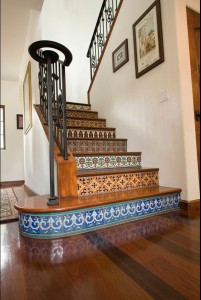 Ceramic and Talavera Mexican Tile work well in the kitchen for two reasons: They’re easy to clean and last for years. But kitchen tile also has its drawbacks.
Ceramic and Talavera Mexican Tile work well in the kitchen for two reasons: They’re easy to clean and last for years. But kitchen tile also has its drawbacks.
The tiles are easy to clean but the grout can darken and look dirty over time. That a tile floor or backsplash lasts for years is a testament to durability, but if you discover, after installation, you don’t like the tile or it limits your redecorating options, you may regret your choice. But removing tile is difficult and costly, so you may just have to live with it.
Before making your choices, then, consider the following tips. They may prevent you making a decision you’ll regret.
Ceramic and porcelain tiles are more commonly used in kitchens than travertine or natural stone tiles. Ceramic tiles are made from clay forms and have a kind of photograph sealed onto the surface. Porcelain tiles are made from a porcelain material and so maintain the same color throughout.
If a ceramic tile chips, you will see the clay base. If porcelain chips, the same color and pattern shows.
Porcelain is a little more expensive than ceramic, but not by much. The choice, then, usually comes down to color and pattern, rather than actual material.
Color and pattern are the most important factor for tile because you do not want to have to tear it out after installation because you want to change your kitchen colors. Choose a neutral, versatile color and pattern so you can change your decorating scheme without worrying about matching the flooring and backsplash.
Your basic color categories are white, brown and gray. Choose creamy white if you tend toward cottage, country or contemporary styles. Choose pure whites if like Scandinavian or modern styles. Beige tones work well with eclectic or traditional styles. If you prefer farmhouse or ethnic styles, choose darker hues in the brown family. Gray tiles work well with modern styles and with certain Mediterranean styles such as Moroccan.
Size is the next consideration. It’s a common misconception that small tiles need to be used for small kitchens. Larger tiles such as 16×16 and 18×18 inch provide balance in a space with large fixtures. The appliances in your kitchen dominate the space with their scale, and you have an expanse of cabinetry and countertop. Using small tiles throws off the balance; the result is big things sitting on little things.
The more common tile size is 12×12, and this size works well in most kitchen settings. But remember to keep your backsplash proportionate to your floor tile size.
For a 12×12 tile size on the floor, you can use the small 1×1 or 2×2 tiles on your backsplash. You can even go up to 8×4 tiles. If you opt for larger tiles on your floor, and want small tiles on your backsplash, choose a bold pattern for the backsplash. This will keep it from “getting lost”.
Mexican Copper Sink – How They Add Style To Your Kitchen/Bathroom
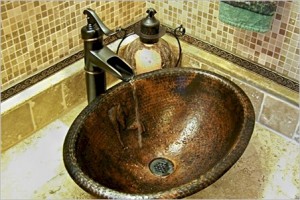 The aesthetically pleasing looks of a Kitchen Copper Sinks are enjoying something of a renaissance in present times. This style of sink has been around for centuries but its appeal is in its timelessness. They are truly unique looking and are akin to having a piece of working art suspended in your kitchen or bathroom! Copper kitchen sinks add a touch of class to both a vintage or a modern kitchen as they seem aged but at the same time ageless. A lot of the attractiveness is due to the unique visuals of copper and yet what most folks do not appreciate is that there are also some functional facets of owning a copper sink. As copper itself is an antimicrobial surface, a sink made with this component is unique in that it is both germ free and and has the ability to naturally heal itself. The benefit to the owner is a germ-free kitchen for ones family, which in turn, minimizes the risks of diseases and illnesses inside the household.
The aesthetically pleasing looks of a Kitchen Copper Sinks are enjoying something of a renaissance in present times. This style of sink has been around for centuries but its appeal is in its timelessness. They are truly unique looking and are akin to having a piece of working art suspended in your kitchen or bathroom! Copper kitchen sinks add a touch of class to both a vintage or a modern kitchen as they seem aged but at the same time ageless. A lot of the attractiveness is due to the unique visuals of copper and yet what most folks do not appreciate is that there are also some functional facets of owning a copper sink. As copper itself is an antimicrobial surface, a sink made with this component is unique in that it is both germ free and and has the ability to naturally heal itself. The benefit to the owner is a germ-free kitchen for ones family, which in turn, minimizes the risks of diseases and illnesses inside the household.
Probably the most important thing you need to contemplate when getting a sink made of copper will be the quality within the copper itself. When purchasing a sink made of copper always make a point of shopping in person. With an popular product markets become awash with inferior imported knockoffs. Sinks making use of inferior materials are tough to maintain as low-quality sinks of copper will stain very easily thus making a potential show-piece actually end up ruining the whole appearance of your kitchen. As with most things in life it’s definitely worth paying extra for better quality. You cannot go wrong if you purchase copper household sinks manufactured in either the USA or Mexico. Shop from a reputable dealer and ask for a quality guarantee.
The other thing that’s worth keeping an eye on in is the gauge (or weight/thickness) of the copper used. Ask the dealer the gauge of the copper (the lower the number the thicker the metal). A lighter gauge will save you money but it will end up denting and warping so it’s not really a good option.
There are four types of different copper finish you also need to be aware of. For those looking for darker shades then opt for Dark Smoke or Rio Grande while the lightest shade is cafe natural. Finally there is Matte copper.
The thing that puts many people off purchasing a Mexican copper sink is the cost but what needs to be considered is that each sink is a major task for the workers as they are all individually handmade and not rolled off a production line. These hard working guys typically work in teams and craft your sink using old-school tools of hammers and chisels just as they were made centuries ago. A beautiful piece like this doesn’t come easily and involves a lot of effort. It’s worth paying a little bit more for this expertise and the unique product they deliver to us.
With so many choices of sinks made of copper on the market today (there’s the copper apron sink, countertop, hammered sink and farmhouse to name just a few!) the hardest choice you will need to make is what Mexican copper sink to spend your money on!
Using Ceramic Tiles to Make Your Kitchen Countertops Look Great
Of the many investments that you can make in your home, bathrooms, bedrooms, living rooms, etc. thoughts often turn towards the kitchen. With a wide variety of ideas for installing new flooring, cabinets, appliances; perhaps one of the most difficult decisions to make is what to do with the kitchen counter tops. With a wide variety of options including the use of ceramic tiles or other options like laminates, butcher block, stainless steel, or perhaps going with stone counter tops, there are many decisions that need to be made that encompass the areas of cost, style, and durability. Fitting nicely into all three of these categories is the use of ceramic tiles for finishing your kitchen counter tops.
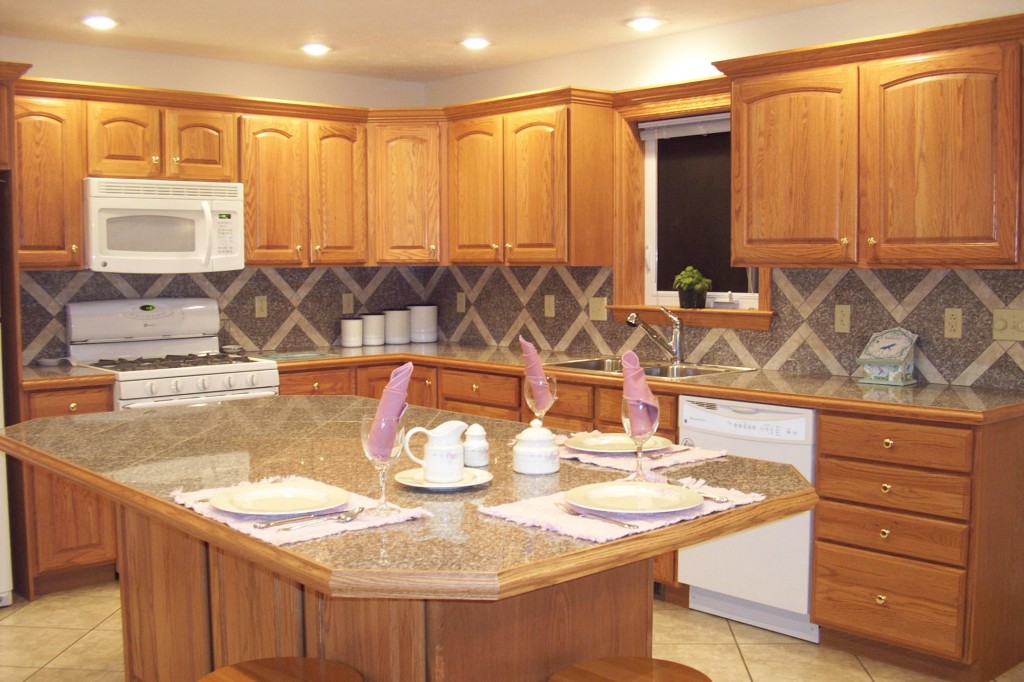
Unlike the other alternatives, ceramic tiles offer the potential for making a very unique decorative statement that just is not possible with laminates, butcher block, stainless steel, or stone products. Stainless steel, well, it looks like stainless steel, not much of an opportunity to make a real design statement there, and many think that this product gives a kitchen an institutional look. Laminates can be picked from a broad selection of designs, but you are pretty much stuck with that one pattern throughout the whole kitchen. Butcher block counter tops, although beautiful at the start are difficult to maintain that way. And stone? Although very attractive and durable the cost of stone counter tops is prohibitive to most on a tight budget. Ceramic tile is the one product that offers the durability of stone, the ability to create unique designs, and affordability.
Ceramic tiles, available in a wide variety of colors, textures, shapes, and sizes offer a very unusual design opportunity for the very creative or the artistically inclined. With the ability to do more than just create countertops with linear design’s, ceramic tiles can be used to create squares, triangles, circles, almost any shape that the mind can imagine. Some homeowners have been known to create elaborate mosaics on their kitchen counter tops making them one of a kind and the envy of many of their friends and family.
Ceramic tiles, able to hold up to extreme temperatures, being exceptionally stain resistant and very hard to scratch, are a wonderful choice for the most used area of the kitchen. Subject to the heaviest traffic in the kitchen from making sandwiches to preparing five course meals for that special dinner party, your kitchen counter tops see action morning, noon, and night. When selecting ceramic tile as the material for your counter tops, care should be taken to make sure that acrylic or epoxy grout is used in the installation to avoid any potential staining of the grout holding the tiles in place.
